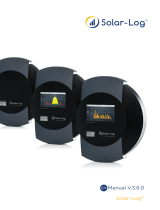
Universal Measuring Device UMG 503
Page 6 = Key 1 = Key 2 = Key 3= Max. value or consumption = Min. value or supply
Intended use
The UMG 503 is suited for fix mounting and the
measurement of voltage, current, harmonics (2nd to 20th),
power etc. in low and medium voltage switchgear. For the
operation of the UMG 503 a protective wire is required.
The measurement is laid out for one phase and three phase
systems with or without neutral conductor (three wire
measurement). In networks without N conductor, the voltage
measurement must be carried out via voltage transformers.
If the measurement should be carried out via two voltage
transformers only, the option "three wire measurement" is
required.
Alternating voltages (50Hz/60Hz) up to 500VAC against
ground and 870VAC between the outer conductors can be
connected directly. The voltage measurement inputs are
not separated galvanicly and must be connected to the
UMG 503 via external prefuses M2A.
The current measurement is carried out via a ../5A or ../1A
current transformer. In networks with a voltage up to 150
VAC against ground currents up to 6 A can be connected
to the UMG 503 directly and measured as well.
The connection of the auxiliary voltage, the measurement
inputs etc. are on the rear side via all-insulated plug
connectors.
The auxiliary voltage must be connected to the building
installation via a separation (switch or power switch) and
a 10 A overload protection.
Product description
Functional description
The electronical three phase measurement system
determines and digitalizes the effective values of voltages
and currents in 50/60 Hz networks.
Two random test measurements are carried out each se-
cond on all current and voltage measuring inputs. Signal
interruptions, which are longer than 500ms are surely
recognized. For each random test two periods are scanned.
From those sampled values the microprocessor calculates
the electric magnitudes. These measured values are
indicated within the programmable display.
Highest values, lowest values and programming data can
be saved in a battery buffered storage. Selected measured
values will be saved with date and time in a ring buffer.
Please note, that the internal clock of the UMG 503 has got
no automatical summer/wintertime change over.
Hints for maintenance
Attention!
Before delivery the device is tested in various safety checks
and marked with a seal. If the device is opened, these
checks must be repeated.
There is no guarantee for devices, which are opened out of
the manufacturing works.
Repairing and calibration
Repairing and calibration work can be carried out in the
manufacturing works only.
Front foil
The cleaning of the front foil must be done with a soft cloth
using a common cleansing agent. Acid or acidic agents may
not be used for cleaning.
Battery
The life expectance of the battery is 5 years minimum for
a storage temperature of +45°C. The typical life expectance
of the battery is about 8 to 10 years. The battery is plumbed
and should be exchanged in the manufacturing works only.
Waste management
The UMG 503 can be disposed as electronical waste
according to the legal regulations and recycled. Please
note, that the input Lithium battery must be disposed
separately.
Hints for usage
This device may be put into service and used by qualified
personnel according to the safety regulations and
instructions only. Please mind the additional legal and
safety regulations for the respective application.
Qualified personnel are persons, familiar with erection,
mounting, putting into service and usage of the product and
having the qualifications such as:
education or instruction / entitlement to switch, release,
ground or characterize current circuits and devices
according to the standards of safety techniques.
education or instruction in the care and usage of suitable
safety equipment according to the standards of safety
techniques.
Attention!
Measurement in systems with pulse load is not possible,
because no continuous scanning of the measuring signals is
carried out.
Note:
The device is conformed for year 2000 according to
DP2000-1:1998 of BSI (British Standards Institution).






















